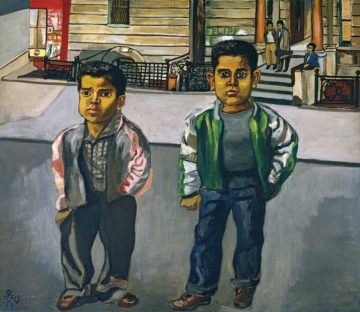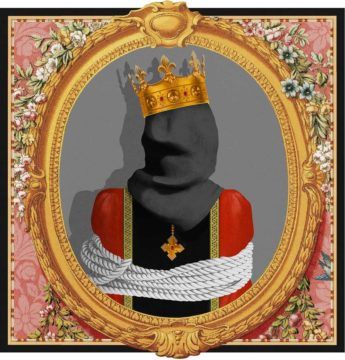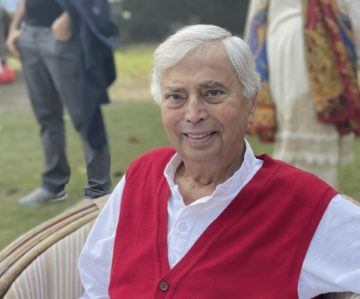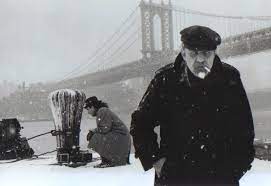Paul Halpern at Literary Hub:
 Resolving the great cosmological debate of the mid-20th century was not on their agenda. Yet in 1964, astrophysicists Arno A. Penzias and Robert W. “Bob” Wilson unexpectedly discovered a radio hiss that turned out to be relic radiation from the early universe. Much to their surprise, their finding, after being interpreted and published the following year, helped settle a long-standing argument about time and space. The Big Bang theory postulated the universe had been created with an initial burst of matter and energy, whereas the steady-state theory—its main rival—described no primordial eruption but rather a slow, continuous creation of material that remains ongoing. The Penzias-Wilson discovery of background radiation tipped the scale toward the Big Bang, away from the steady-state.
Resolving the great cosmological debate of the mid-20th century was not on their agenda. Yet in 1964, astrophysicists Arno A. Penzias and Robert W. “Bob” Wilson unexpectedly discovered a radio hiss that turned out to be relic radiation from the early universe. Much to their surprise, their finding, after being interpreted and published the following year, helped settle a long-standing argument about time and space. The Big Bang theory postulated the universe had been created with an initial burst of matter and energy, whereas the steady-state theory—its main rival—described no primordial eruption but rather a slow, continuous creation of material that remains ongoing. The Penzias-Wilson discovery of background radiation tipped the scale toward the Big Bang, away from the steady-state.
Though many researchers had contributed to the development of each theory, in the public mind the debate came down to a clash between two extraordinarily brilliant—and charmingly quirky—figures. Since the late 1940s, Russian Ukrainian American physicist George Gamow—a master of exceptional insights and outrageous puns—had carried the banner of the Big Bang (though he didn’t like that expression), and British astrophysicist Fred Hoyle—known for his stubborn persistence, maverick ideas, and passion for long-distance hiking—had tenaciously advocated the steady-state alternative.
More here.

 “You can’t put the genie back in the bottle.” Those of us eager to get rid of nuclear weapons hear this a lot and at first glance it seems true; common sense suggests that neither genies nor nuclear weapons are readily rebottled. But this “common sense” is uncommonly wrong. Technologies have appeared throughout human history and just as the great majority of plant and animal species have eventually gone extinct, ditto for the great majority of technological genies. Only rarely have they been forcibly restrained or erased; nearly always they have simply been abandoned once people recognized they were inefficient, unsafe, outmoded, or sometimes just plain silly.
“You can’t put the genie back in the bottle.” Those of us eager to get rid of nuclear weapons hear this a lot and at first glance it seems true; common sense suggests that neither genies nor nuclear weapons are readily rebottled. But this “common sense” is uncommonly wrong. Technologies have appeared throughout human history and just as the great majority of plant and animal species have eventually gone extinct, ditto for the great majority of technological genies. Only rarely have they been forcibly restrained or erased; nearly always they have simply been abandoned once people recognized they were inefficient, unsafe, outmoded, or sometimes just plain silly. By now Sandra Oh’s hive of devoted fans have likely binged all six episodes of her
By now Sandra Oh’s hive of devoted fans have likely binged all six episodes of her  “I first met John Lennon through Tony King, who had moved to LA to become Apple Records’ general manager in the US. In fact, the first time I met John Lennon, he was dancing with Tony King. Nothing unusual in that, other than the fact that they weren’t in a nightclub, there was no music playing and Tony was in full drag as Queen Elizabeth II. They were at Capitol Records in Hollywood, where Tony’s new office was, shooting a TV advert for John’s forthcoming album Mind Games, and, for reasons best known to John, this was the big concept.
“I first met John Lennon through Tony King, who had moved to LA to become Apple Records’ general manager in the US. In fact, the first time I met John Lennon, he was dancing with Tony King. Nothing unusual in that, other than the fact that they weren’t in a nightclub, there was no music playing and Tony was in full drag as Queen Elizabeth II. They were at Capitol Records in Hollywood, where Tony’s new office was, shooting a TV advert for John’s forthcoming album Mind Games, and, for reasons best known to John, this was the big concept. What is it like to work in an Indian factory? Three documentaries (all currently streaming for free) begin to answer this troubling question. Anjali Monteiro and KP Jayasankar’s
What is it like to work in an Indian factory? Three documentaries (all currently streaming for free) begin to answer this troubling question. Anjali Monteiro and KP Jayasankar’s  Neel took the call to realism to heart: She went out into the streets of Philadelphia to paint and attended a local sketch club where the models were ordinary people. (She was also part of the first generation of female art students allowed to study live male nudes.) The path of realism reflected how Neel understood her place in the world. “I had a conscience about going to art school,” she said. “Because when I’d go into the school, the scrub-women would be coming back from scrubbing office floors all night. It killed me that these old gray-headed women had to scrub floors, and I was going in there to draw Greek statues.”
Neel took the call to realism to heart: She went out into the streets of Philadelphia to paint and attended a local sketch club where the models were ordinary people. (She was also part of the first generation of female art students allowed to study live male nudes.) The path of realism reflected how Neel understood her place in the world. “I had a conscience about going to art school,” she said. “Because when I’d go into the school, the scrub-women would be coming back from scrubbing office floors all night. It killed me that these old gray-headed women had to scrub floors, and I was going in there to draw Greek statues.” JORGE LUIS BORGES: I dream every night. I dream before I go to sleep, and I dream after waking up. When I begin to say meaningless words, I’m seeing impossible things.
JORGE LUIS BORGES: I dream every night. I dream before I go to sleep, and I dream after waking up. When I begin to say meaningless words, I’m seeing impossible things. Not only do researchers often depict the brain and its functions much as mapmakers might draw nations on continents, but they do so “the way old-fashioned mapmakers” did, according to
Not only do researchers often depict the brain and its functions much as mapmakers might draw nations on continents, but they do so “the way old-fashioned mapmakers” did, according to  Those of us who argued against the war possessed no prophetic powers. I
Those of us who argued against the war possessed no prophetic powers. I  I
I Let’s say you’re at a big office party full of people, both coworkers and strangers, when someone walks up to you. You have a split second to determine if you know this person or not; you don’t want to make the faux pas of re-introducing yourself to your receptionist. Luckily, your brain is adept at what computer scientists call “novelty detection”—the ability to distinguish new information from details that have been encountered before. Most of the time we do it effortlessly. How exactly that skill works is a provocative scientific mystery, however.
Let’s say you’re at a big office party full of people, both coworkers and strangers, when someone walks up to you. You have a split second to determine if you know this person or not; you don’t want to make the faux pas of re-introducing yourself to your receptionist. Luckily, your brain is adept at what computer scientists call “novelty detection”—the ability to distinguish new information from details that have been encountered before. Most of the time we do it effortlessly. How exactly that skill works is a provocative scientific mystery, however. My father died at 2:15 pm last Sunday. I would like to say that he died in my arms, but the truth is that by the time I heard my sister scream and ran in from the next room, he had already moved on from this world.
My father died at 2:15 pm last Sunday. I would like to say that he died in my arms, but the truth is that by the time I heard my sister scream and ran in from the next room, he had already moved on from this world. The question of subjectivity had been very much on my mind that summer. A few months earlier I’d been commissioned by a magazine to review several new books on consciousness. All of the authors were men, and I was surprised by how often they acknowledged the deeply personal motivations that led them to their preferred theories of mind. Two of them, in a bizarre parallel, listed among these motivations the desire to leave their wives. The first was Out of My Head, by Tim Parks, a novelist who had become an advocate for spread mind theory—a minority position that holds that consciousness exists not solely in the brain but also in the object of perception. Parks claimed that he first became interested in this theory around the time he left his wife for a younger woman, a decision that his friends chalked up to a midlife crisis. He believed the problem was his marriage—something in the objective world—while everyone else insisted that the problem was inside his head. “It seems to me that these various life events,” he wrote, “might have predisposed me to be interested in a theory of consciousness and perception that tends to give credit to the senses, or rather to experience.”
The question of subjectivity had been very much on my mind that summer. A few months earlier I’d been commissioned by a magazine to review several new books on consciousness. All of the authors were men, and I was surprised by how often they acknowledged the deeply personal motivations that led them to their preferred theories of mind. Two of them, in a bizarre parallel, listed among these motivations the desire to leave their wives. The first was Out of My Head, by Tim Parks, a novelist who had become an advocate for spread mind theory—a minority position that holds that consciousness exists not solely in the brain but also in the object of perception. Parks claimed that he first became interested in this theory around the time he left his wife for a younger woman, a decision that his friends chalked up to a midlife crisis. He believed the problem was his marriage—something in the objective world—while everyone else insisted that the problem was inside his head. “It seems to me that these various life events,” he wrote, “might have predisposed me to be interested in a theory of consciousness and perception that tends to give credit to the senses, or rather to experience.” Every great urban filmmaker has a personal metaphysics of the city, a sense that the synergies and mysteries of urban life can find their ideal form in images. That’s what Pola Rapaport reveals in her first feature, “Broken Meat,” from 1991, which is showing, starting Wednesday, on
Every great urban filmmaker has a personal metaphysics of the city, a sense that the synergies and mysteries of urban life can find their ideal form in images. That’s what Pola Rapaport reveals in her first feature, “Broken Meat,” from 1991, which is showing, starting Wednesday, on  We humans have a profound impact on the world around us. Bob Paine, the groundbreaking American ecologist, once described us as a “hyperkeystone” species: our actions affect the lives and habitats of other creatures more than any other species on Earth. So much so, some scientists have adopted the term
We humans have a profound impact on the world around us. Bob Paine, the groundbreaking American ecologist, once described us as a “hyperkeystone” species: our actions affect the lives and habitats of other creatures more than any other species on Earth. So much so, some scientists have adopted the term